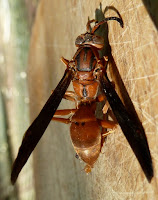 |
| Yellow banding on abdomen helps identify P. fuscatus - REK |
 |
| P. metricus |
These are social wasps in a matriarchy with a solitary queen although her "court" sometimes has other female queens that serve her. Occasionally they will share their paper nest with P. metricus. When they first emerge there may be fighting between the females until one establishes dominance. This is a battle of reproductive strength where the dominant queen usually has the largest and most developed ovaries.
There is evidence that the wasps can recognize individual nest mates by their appearance. When an individual was painted with black and yellow paint to change its features, it was greeted with aggression which let up with time, unlike a wasp from another nest, suggesting that chemical clues are more important in nest mate recognition.

There is extensive information on every stage of P. metricus life here. This was the species that was studied in understanding frass-flinging caterpillars. Caterpillars of silver-spotted skippers (Epargyreus clarus) were paired with P. metricus to determine the benefits of "flinging" frass (caterpillar poop) shooting it away from their leaf shelters. We have a video of the frass flying out here, a fun sight before delving into the scientific experiments. I will try to keep in mind the wasps' contributions to entomological research the next time I find them inside our bedroom window.